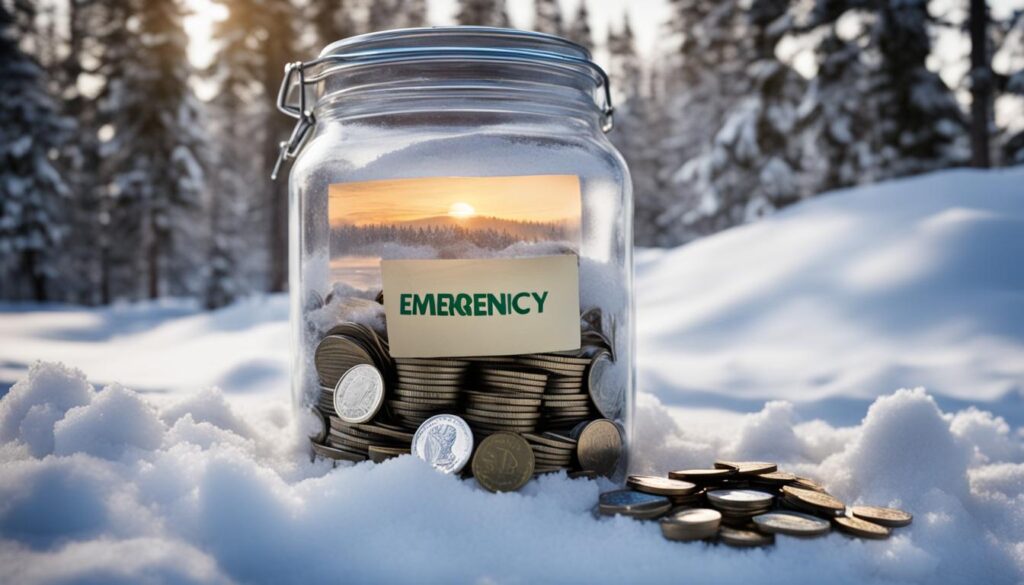Winter can bring about unexpected expenses, from increased heating costs to the need for winter gear. Planning and budgeting for these expenses is crucial to avoid financial strain during the colder months. By following expert strategies, you can effectively manage your finances and ensure a smooth winter season.
Key Takeaways:
- Winter budget planning is essential for managing the financial impact of the colder months.
- Track your spending to identify non-essential costs that can be eliminated.
- Create a budget and allocate your funds wisely.
- Prioritize paying down debt to improve your financial situation.
- Build an emergency fund to mitigate the financial impact of unexpected expenses.
Start Tracking Your Spending
When it comes to winter budget planning, one of the most important steps is to start tracking your spending. By keeping a record of your expenses, you can gain valuable insights into your financial habits and identify areas where you can cut back. This will help you eliminate non-essential costs and save money for the winter season.
To track your spending effectively, start by categorizing your expenses. Divide them into categories such as groceries, transportation, entertainment, and others. This will give you a clear overview of where your money is going and help you identify any unnecessary expenses.
One aspect of spending that can significantly impact your budget is online shopping. With the convenience of online retailers, it’s easy to overspend without realizing it. To stay within your budget, set a specific online shopping budget and stick to it. Avoid impulse purchases and compare prices before making a decision. By being mindful of your online shopping habits, you can keep your budget on track.
Start Tracking Your Spending
Tracking your spending is a crucial step in winter budget planning. By categorizing your expenses and eliminating non-essential costs, you can save money and allocate your funds more effectively. Don’t underestimate the impact of online shopping on your budget. Set a specific online shopping budget and be mindful of your spending habits. By implementing these strategies, you can take control of your finances and ensure a smooth winter season.
| Category | Amount Spent |
|---|---|
| Groceries | $300 |
| Transportation | $150 |
| Entertainment | $100 |
| Online Shopping | $200 |
| Total | $750 |
Table: Breakdown of Spending Categories
By tracking your spending, you can gain a better understanding of where your money is going. This table provides a clear breakdown of different spending categories and the corresponding amounts spent. Use this information to identify areas where you can cut back and save money for your winter expenses.
Remember, tracking your spending is just the first step in effective budget planning. Stay tuned for the next section, where we will discuss how to create a budget that aligns with your financial goals and helps you prepare for the winter season.
https://www.youtube.com/watch?v=97h9Dcoocuc
Create a Budget
When it comes to effective winter budget planning, creating a budget is a crucial step. By allocating your funds strategically, you can ensure that your essential expenses are covered while also saving for the future, such as retirement. Here are some key considerations for creating a budget:
- Identify essential expenses: Start by listing your essential expenses, such as rent or mortgage payments, utilities, groceries, and transportation costs. These are the necessary expenses that you must allocate funds towards each month.
- Allocate funds: Once you have identified your essential expenses, allocate a portion of your income towards each category. This will ensure that you have enough funds set aside for these key areas.
- Consider non-essential expenditures: While essential expenses should be a priority, it’s important to also account for non-essential expenditures, such as entertainment or dining out. Set a limit for these categories to avoid overspending.
- Savings for retirement: As you create your budget, be sure to allocate a portion of your income towards savings, including retirement savings. Planning for the future is crucial for long-term financial stability.
By creating a budget that outlines your essential expenses, allocates funds appropriately, and includes savings for retirement, you can effectively manage your finances during the winter months and beyond.
| Category | Allocation |
|---|---|
| Rent/Mortgage | 25% of income |
| Utilities | 10% of income |
| Groceries | 15% of income |
| Transportation | 10% of income |
| Entertainment | 5% of income |
| Savings (including retirement) | 20% of income |
| Non-essential expenses | 15% of income |
Creating a budget allows you to take control of your finances and prioritize your spending. By accurately allocating your funds towards essential expenses and savings, you can minimize any financial strain during the winter months and ensure a stable financial future.
Pay Down Debt
When it comes to winter budget planning, paying down debt should be a top priority. By prioritizing your debt and making extra payments, you can reduce your overall debt burden and free up more funds for other essential expenses. Start by evaluating your debts and identifying which ones have the highest interest rates. These are the ones you should focus on paying off first, as they tend to cost you more in the long run.
To effectively pay down debt, consider making more than the minimum monthly payments on your credit cards. By allocating additional funds towards your credit card bills, you can reduce the amount of interest that accrues and pay off your balances faster. Additionally, it’s important to avoid accumulating more debt during the winter season. Try to use cash or debit cards for purchases instead of relying on credit cards.
Another strategy for paying down debt is to save money specifically for debt payments. Calculate how much money you need to cover essential expenses and allocate a portion of your income towards debt repayment. By treating debt payment as a necessary expense, you can make consistent progress in reducing your debt. Set realistic goals for yourself and track your progress regularly to stay motivated.
| Debt | Interest Rate | Minimum Payment | Extra Payment | Remaining Balance |
|---|---|---|---|---|
| Credit Card A | 18% | $50 | $100 | $500 |
| Credit Card B | 22% | $75 | $150 | $1,000 |
| Student Loan | 5% | $200 | $0 | $5,000 |
Table: Debt Repayment Progress
The table above illustrates a sample debt repayment plan. By making extra payments towards Credit Card A and Credit Card B, the remaining balances decrease over time. The student loan, which has a lower interest rate, can be paid off with the minimum payment until higher interest debts are taken care of. Keep in mind that everyone’s debt situation is different, so adjust your repayment plan accordingly.
Build Your Emergency Fund
In order to prepare for unexpected expenses that can arise during the winter months, it is crucial to build an emergency fund. This fund will serve as a financial safety net and provide you with peace of mind knowing that you have a cushion to fall back on when unforeseen circumstances occur. By setting aside money specifically for emergencies, you can navigate through challenging times without straining your budget or resorting to debt. Additionally, incorporating rainy day budgeting strategies can further enhance your preparedness for such situations. This involves allocating a portion of your monthly income to your emergency fund and cutting back on non-essential spending. By consistently contributing to this fund and developing a budget that prioritizes savings, you’ll foster a sense of financial stability that can carry you through even the most unpredictable winter challenges.
When building your emergency fund, it is important to set a specific savings goal. Determine how much you would like to have in your fund, taking into consideration your monthly expenses and the potential costs of any emergencies that may arise. Aim to save enough to cover at least three to six months’ worth of expenses. While it may take time to reach this goal, it is a worthwhile endeavor that will provide you with greater financial security.
To save for emergencies, allocate a portion of your income towards your emergency fund each month. Treat it as a non-negotiable expense, just like your rent or utility bills. Consider automating your savings by setting up automatic transfers from your checking account to your emergency fund so that you consistently contribute without having to remember to do so manually. Additionally, look for ways to cut back on non-essential expenses in order to free up more money for your emergency fund. This may involve making small sacrifices in your daily spending habits, such as bringing lunch from home instead of eating out or reducing entertainment expenses.

By prioritizing the building of your emergency fund, you are protecting yourself and your finances from the impact of unexpected expenses. It is better to be prepared for emergencies rather than facing the stress of financial strain when they arise. Start saving for emergencies today and create a more secure financial future for yourself.
Conclusion
Winter budget planning is essential for managing the financial impact of the colder months. By implementing effective budgeting strategies, you can ensure financial stability and navigate winter expenses more effectively.
Start by tracking your spending and identifying non-essential costs that can be eliminated. This will help you allocate your funds more efficiently and free up money for winter expenses. Creating a budget is key, as it allows you to prioritize essential expenses and set aside savings for retirement or emergencies.
Prioritizing debt and building an emergency fund are also crucial steps in winter budget planning. By paying down debt, you can improve your financial situation and reduce financial stress. Building an emergency fund provides a safety net for unexpected expenses that may arise during the winter months.
By following these budgeting strategies and planning for tax season, you can achieve financial stability and ensure that your budget remains on track throughout the winter season and beyond. Start your winter budget planning today to stay ahead of your finances and enjoy a stress-free winter.
FAQ
What is winter budget planning?
Winter budget planning is the process of tracking your expenses, creating a budget, prioritizing debt, and building an emergency fund to effectively manage your finances during the colder months.
Why is tracking spending important for winter budget planning?
Tracking your spending allows you to identify non-essential costs that can be eliminated, helping you save money and allocate your funds more effectively.
How can I create a budget for winter expenses?
Creating a budget involves allocating your money towards essential expenses, updating it to include changes in rent or utility bills, and dividing your income into fixed expenses, non-essential expenditures, and savings for retirement or emergencies.
How can I prioritize my debt during winter budget planning?
Prioritizing debt involves paying more towards your monthly credit card bills to pay them off faster and planning your spending by adding the same dollar amount to savings as you want to spend.
Why should I build an emergency fund for winter?
Building an emergency fund is important because unexpected expenses can arise during the winter months. Having an emergency fund in place can help cover these expenses and provide financial security.
What are the benefits of winter budget planning?
Winter budget planning helps you navigate winter expenses more effectively, achieve financial stability, and ensure that your budget remains on track during the colder season and beyond.
Can I Use the Same Budgeting Strategies for Winter Expenses as I Do for Summer Expenses?
When it comes to budgeting tips for summer and winter expenses, different approaches may be needed. While some strategies can be applied year-round, others are specific to each season. Factors like utility bills, seasonal activities, and holiday expenses require separate budgeting plans. Properly adapting your budgeting strategies can help you effectively manage expenses in both summer and winter.
How Can I Budget for Spring Expenses?
Spring is the perfect time for a budget refresh for spring cleaning finances. Start by assessing your expenses from the past months and identifying areas where you can cut back. Set goals for saving, create a budgeting plan, and stick to it. Consider reallocating funds for seasonal activities and maintenance tasks, while keeping a close eye on your overall financial well-being.

